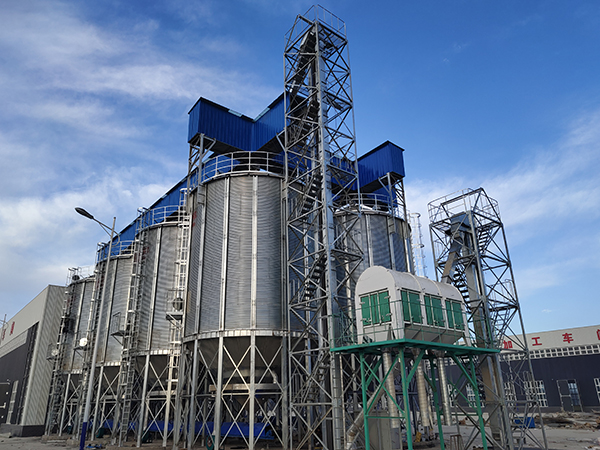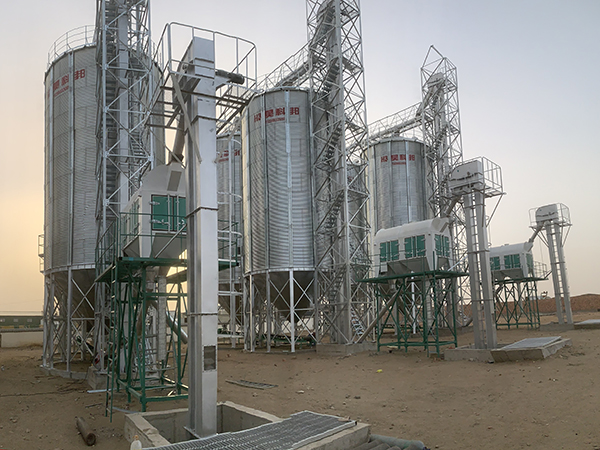1000-ton hopper bottom silo
A 1000-ton hopper bottom silo is a type of silo capable of storing approximately 1000 tons of material and features a hopper bottom structure. This type of silo is typically used for storing and handling large quantities of bulk materials, such as grains, seeds, feed, fertilizer, and powdered materials.
1000-ton hopper bottom silo Introduction
A 1000-ton hopper bottom silo is a type of silo capable of storing approximately 1000 tons of material and features a hopper bottom structure. This type of silo is typically used for storing and handling large quantities of bulk materials, such as grains, seeds, feed, fertilizer, and powdered materials. Compared to smaller-capacity hopper bottom silos, the 1000-ton hopper bottom silo offers a larger storage capacity, making it suitable for applications requiring larger-scale and longer-term storage needs.


Features of 1000 ton hopper bottom silo
Large Capacity
Capable of storing up to 1000 tons of materials.
Hopper Bottom
The bottom is designed in a hopper shape to promote the flow and discharge of materials.
Structural Stability
Features a robust structural design to support the weight of a large amount of materials.
Loading and Unloading System
Equipped with an efficient conveying system, such as belt conveyors or screw conveyors, for easy loading and unloading of materials.
Sealing Performance
Good sealing performance to protect materials from environmental influences.
Durability
Constructed from durable materials like carbon steel or stainless steel, and may also undergo additional anti-corrosion treatments.
Easy Maintenance
Designed with maintenance in mind, including easily accessible inspection hatches and maintenance passages.
Wide Applicability
Suitable for a variety of different bulk material storage needs.


The structure of the 1000 ton hopper bottom silo
Silo Shell
The main body of the silo, made from durable materials such as carbon steel or stainless steel, and often galvanized or coated for additional protection against corrosion.
Hopper Bottom
The lower part of the silo is designed with a converging angle that allows materials to flow smoothly towards the discharge point with minimal hang-up.
Top Structure
Includes the top cover or cap which may have a flat or domed shape, designed to seal the contents and protect them from the environment.
Discharge System
Located at the bottom of the hopper, this system can include a cone, a manhole, or a more complex mechanism like a slide gate or a bottom discharge valve for controlled material release.
Conveying Equipment
Such as conveyor belts, screw conveyors, or bucket elevators, which transport the material out of the silo.
Support Structure
Columns, beams, or other structural elements that provide the necessary support to the silo’s weight and ensure stability.
Ladders and Platforms
For safe access to the top of the silo and other maintenance areas.
Access Hatches
Manholes and other access points for inspection, maintenance, and cleaning of the silo interior.
Ventilation System
To regulate air flow and prevent condensation or buildup of harmful gases within the silo.
Pressure Relief System
To manage pressure inside the silo, especially important for silos containing materials that can generate gases.
Monitoring and Control System
May include sensors for level, temperature, humidity, and other critical parameters, along with a control panel for operational management.
Safety Features
Such as fire suppression systems, lightning protection, and other safety measures to ensure the safe operation of the silo.

Advantages of 1000 ton hopper bottom silo
Large Storage Capacity
With the ability to hold up to 1000 tons of material, it provides substantial storage space for various bulk commodities.
Efficient Discharge
The hopper-bottom design ensures efficient material flow and discharge, reducing the chances of arching or ratholing that can obstruct flow in other types of silos.
Structural Integrity
These silos are built with robust materials and construction techniques to ensure they can withstand the weight and pressure of fully loaded storage.
Minimized Dead Volume
The hopper shape minimizes the area where material can become trapped or stagnant, which is crucial for maintaining the quality of stored materials over time.
Easy Maintenance
Access hatches, ladders, and platforms facilitate routine inspections and maintenance, contributing to the longevity of the silo.
Versatility
Suitable for a wide range of bulk materials, including granular, powdery, and even some types of liquid materials, depending on the design.
Durability
The use of high-quality materials and protective coatings or treatments extends the service life of the silo and protects against environmental factors.
Cost-Effectiveness
While the initial investment may be significant, the long-term savings on storage efficiency and reduced maintenance costs make it a cost-effective solution.
Safety Features
Incorporating safety features such as pressure relief systems and fire suppression can help prevent accidents and protect the stored material.
Environmental Control
The silo can be equipped with a ventilation system to control the internal environment, preventing condensation and maintaining the quality of the stored product.
Automation Capabilities
The potential for integration with automated control systems allows for remote monitoring and operation, increasing efficiency and reducing labor costs.
Application scope of Hopper bottom silo
Coban Silo is widely used for grain storage such as wheat, corn, soybean, paddy, rice, soybean meal, barley, malt, sunflower seeds, rapeseed, peanuts, flour, and other powder materials, oat, special Silo, and seeds, etc. Steel silo products include 100 ton, 300 ton, 500 ton, 1000 ton, 2000 ton, 3000 ton, 5000 ton and 10000 ton steel silo as well as metal silo, spiral silo and galvanized silo.

Hopper bottom silo technical parameters
Scientifically speaking, the Silo capacity should be measured with volume (m3). Even in the same grain Silo, the storage tons will be different for different grains with different densities. The following table is calculated based on a Silo density of 0.75kg/m3, and surely HKB customizes Silo systems unique for you.
| Most Popular Hopper Bottom Steel Silo Technical Specifications | ||||||||
| Capacity | 50Ton | 100Ton | 150Ton | 200Ton | 300Ton | 500Ton | 1000Ton | 1500Ton |
| Model | TCZK
03605 |
TCZK
04507 |
TCZK
05507 |
TCZK
06406 |
TCZK
07307 |
TCZK
07313 |
TCZK
11010 |
TCZK
12811 |
| Diameter(m) | 3.667 | 4.584 | 5.500 | 6.417 | 7.334 | 7.334 | 11.000 | 12.834 |
| Total Height(m) | 9.56 | 12.53 | 13.25 | 12.85 | 14.70 | 21.42 | 20.95 | 23.51 |
| Volume(m³)
Density:0.75ton/m³ |
69 | 150 | 222 | 273 | 415 | 699 | 1346 | 2039 |
| Most Popular Flat Bottom Steel Silo Technical Specifications | ||||||||
| Capacity | 1000Ton | 1500Ton | 2000Ton | 2500Ton | 3000Ton | 5000Ton | 8000Ton | 10000Ton |
| Model | TCK
10014 |
TCK
11915 |
TCK
13715 |
TCK
15514 |
TCK
15518 |
TCK
18321 |
TCK
24718 |
TCK
25621 |
| Diameter(m) | 10.084 | 11.918 | 13.750 | 15.584 | 15.584 | 18.334 | 24.751 | 25.668 |
| Total Height(m) | 18.69 | 20.34 | 20.87 | 20.30 | 24.78 | 28.60 | 26.99 | 30.60 |
| Volume(m³)
Density: 0.75ton/m³ |
1335 | 2009 | 2701 | 2467 | 4145 | 6693 | 10879 | 13484 |








